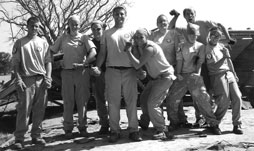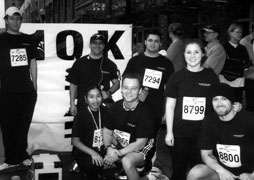By Kristina Ayr/reporter

No matter what is happening in the world, people turn to music as was evidenced in the 1930s, two NE Campus teachers said last week.
Peter Hacker, assistant professor of history, and Wayne Zatopek, professor emeritus of sociology, presented Music of the Great Depression in conjunction with the FDR exhibit This Great Nation Will Endure: Photographs of the Great Depression on NE through March 9.
“ We love music,” Hacker said. “And even at the time of the Depression, people were still creative, and music was the way it was done.”
Their presentation featured 22 different types of songs, each by a different musician, some well-known and some unknown.
“ Music affects culture, and culture affects music,” Zatopek said.
One of the more popular songs of the era, “Brother, Can You Spare a Dime” sung by Bing Crosby, illustrates how the effects of the Depression came out in the songs, Hacker said.
“ When’s the last time you heard a song about food, government agencies, a bed, landlords, getting back at the rich or revenge?” he asked.
All the songs Hacker and Zatopek discussed fit into one of those categories.
“ Coming out of the 1930s, we hear mentions of the Depression in the songs,” Hacker said.
“ There were depression songs, whining songs and even protest songs,” he said.
The song “Poor Man’s Heaven” by Bub Billings is an example of dreaming about food.
The lyrics include “In a poor man’s heaven, we’ll run the whole place/and won’t have nothing to fear/We’ll eat what we want from ham and egg trees/ that grow by the lake full of beer.”
Everyone was clearly struggling even to eat, Hacker said, and to see it expressed in a song shows the effect hunger had on the time and on the people.
The earliest country singer was Vernon Dalhart.
He sang “The Farm Relief Song,” which describes populist days and advocates farmers’ discussing the issues they were facing during the Depression.
Country songs continued with a few more artists such as Jimmie Rodgers singing “Blue Yodel #8” and Gene Autry’s “Back in the Saddle Again.”
Although it was sometimes called hillbilly music, Zatopek said there was no doubt country and religious songs seemed to go hand-in-hand at that time.
The Carter Family and their song “No Depression in Heaven” is an example.
In the song, the Carters reveal their belief that God had predicted this time of despair with the lyrics “the Great Depression now is spreading/God’s word declared it would be so.”
Hacker said religion was pretty big at this time and to have it in a song was a big deal.
The Carters believed God had planned the Depression, and it was a test, and with that in mind they sang their songs.
Other songs were about government agencies, and different artists had their different opinions on what the government was doing for aid, Hacker said.
Songs such as “Casey Bill’s New WPA” by Casey Bill Weldon, “WPA” by Skeets Tolbert and his Gentlemen of Swing, “Don’t Take Away my PWA” by Jimmie Gordon and “NRA Blues” by Ida Cox either praised or criticized the government agencies.
At the time there were also government camps, and some unknown, non-professional children sang songs about being in those camps. “The Cotton Picker’s Song” by Lloyd Stalcup and “Government Camp Song” by Mary and Betty Campbell are two examples.
Hacker said both of these were good songs made by children of the time telling exactly how life was.
The songs describe their hopes for more while they see the reality of the lives.
“ There were hard times, and these children did not soften it at all,” he said.
Some songs of the period, however, did not emphasize the hard times.
Zatopek said swing was coming into the picture and varied from jazz, blues or religious music.
These new popular songs included “Up a Lazy River” by Louis Armstrong, “It Don’t Mean a Thing (If It Ain’t Got That Swing)” by Duke Ellington, “Moonlight Serenade” by Glenn Miller, “Jitterbug” by Cab Calloway and “Sweet Home Chicago” by Robert Johnson.
Some of these songs crossed into more than one genre and become more popular.
However, Zatopek said, sales of records and music drastically dropped during this time, and that decline affected the artists.
Another important transition was going on through all this, Zatopek said. By the end of the Depression, instruments were becoming electric and amplified.

























